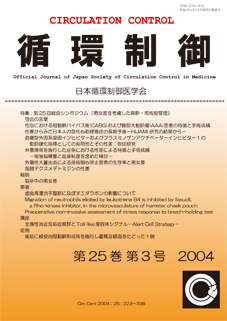巻号一覧

25 巻 (2004)
- 4 号 p. 378-
- 3 号 p. 261-
- 2 号 p. 158-
- 1 号 p. 37-
25 巻, 3 号
選択された号の論文の4件中1~4を表示しています
- |<
- <
- 1
- >
- >|
原著
-
高見 真代, 浦嶋 和也, 西堀 崇子, 廣谷 芳彦, 田中 一彦2004 年 25 巻 3 号 p. 261-266
発行日: 2004年
公開日: 2004/12/06
ジャーナル フリーエダラボンのラット摘出心における虚血再灌流不整脈に対する抑制作用の有無を検討した。心摘出後,ランゲンドルフ法による灌流を開始し,10,25,50,75,100,150μMのエダラボンを溶解した灌流液で10分間灌流後,11分間の虚血を行い,3分間の再灌流を行った。
冠灌流量,心拍数に対するエダラボンの影響は認められず,心室細動(ventricular fibrillation:VF)発生率においてはエダラボン 25,75,100μMでcontrol群に比べ有意に減少した。しかし,各濃度間の有意差は認められなかった。Sustained VF発生率は,control群の92%に対し,エダラボン 25μMで 50%と有意に減少した。エダラボンはラット摘出心の虚血再灌流時の不整脈に対し抑制作用を有することが示唆された。抄録全体を表示PDF形式でダウンロード (277K) -
Akiko Ozawa, Yoshihiro Nara, Hiroshi Kimotsuki, Eri Nakahara, Hirotsug ...2004 年 25 巻 3 号 p. 267-271
発行日: 2004年
公開日: 2004/12/06
ジャーナル フリーThis study was designed to investigate possible effects of a Rho-kinase inhibitor, fasudil, on migration of neutrophils induced by leukotriene B4. The neutrophil behavior was observed in the microvasculature of hamster cheek pouch using a trans-illumination microscope. Superfusion of lekotrience B4 caused an increase in the number of neutrophils adhering the endothelium and migrating through the endothelium outside the venules. The migration induced by lekotrience B4 was significantly attenuated in hamsters receiving intravenous infusion of 10 and 30mg/kg of fasudil prior to the leukotriene B4 superfusion. These results suggest that inhibition of Rho-kinase by fasudil produces an inhibition of neutrophil migration and represents a new therapeutic strategy for neutrophil-mediated tissue damage.抄録全体を表示PDF形式でダウンロード (621K) -
Ken Yamaura, Sumio Hoka, Junichi Yoshimura, Shosuke Takahashi2004 年 25 巻 3 号 p. 272-275
発行日: 2004年
公開日: 2004/12/06
ジャーナル フリーThe purpose of this study was to evaluate circulatory and respiratory responses to a breath-holding stress test in surgical patients at the bed-side using continuous and non-invasive monitoring with arterial tonometry and pulse oxymetry. Sixty-one patients were assigned into four groups: normal healthy patients(Cont), elderly patients(Elder), hypertensive patients(HT) and diabetic patients(DM). The breath-holding stress test was conducted in the supine position at the functional residual capacity level and in room air. Breath-holding time, changes in heart rate(HR), mean arterial pressure(MAP), arterial oxyhemoglobin saturation using a pulse oxymeter(SpO2) and the recovery time of SpO2 were measured. Breath-holding time was significantly shorter in the HT group(30±2.0sec, p<0.05) and tended to be shorter in the Elder group(31±3.0sec, p=0.08) compared with the Cont group(41±2.9sec). The maximum mean arterial blood pressure(Max-MAP) was higher in the Elder(105±4.0mmHg)(p<0.05) and HT(128±5.6mmHg)(p<0.05) groups compared with the Cont group(93±4.0mmHg). However, ΔMAP, ΔHR, Min-SpO2, and ΔSpO2 were not significantly different among the four groups. Our results suggest that non-invasive continuous monitoring facilitates evaluation of stress responses to breath-holding in preoperative patients, and that the breath-holding stress test causes sympathetic augmentation, resulting in increases in MAP and HR by approximately 15%, concomitant with a decrease in SpO2 to 90-94%. The magnitude of the response is similar regardless of age and existence of HT and DM.抄録全体を表示PDF形式でダウンロード (143K)
症例
-
角田 博, 中村 久美, 紀 敦成, 若松 拓彦, 北村 里恵2004 年 25 巻 3 号 p. 285-288
発行日: 2004年
公開日: 2004/12/06
ジャーナル フリーPreoperative application of coronary angiography or percutaneous coronary intervention(PCI) is controversial in Japan. We report a case in which PCI, performed before minor surgery, led to acute myocardial infarction. An 83-year-old woman was scheduled for transurethral resection of a bladder tumor under spinal anesthesia. Her condition was complicated by type 1 diabetes mellitus, and she had a history of myocardial infarctions 21 years and 9 years previously. The ischemic symptoms had not exhibited since the last myocardial infarction under suitable medical treatment. Preoperative coronary angiography was performed, and revealed three-vessel disease. One month later, PCI was performed, but acute myocardial infarction occurred during the procedure, followed by cardiac collapse. The patient was resuscitated without neurological consequences, but was hospitalized for another 187 days. The planned surgery was canceled. This case lets us consider the adoption of ACC/ACH guidelines, in which PCI is not recommended before minor surgery on patients lacking major clinical predictors of increased cardiovascular risk. Otherwise, we have to establish another set of guidelines based on evidence applicable to the Japanese population.抄録全体を表示PDF形式でダウンロード (574K)
- |<
- <
- 1
- >
- >|